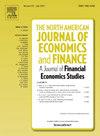加密货币市场的预警系统:使用机器学习预测“僵尸”资产
IF 3.9
3区 经济学
Q1 BUSINESS, FINANCE
North American Journal of Economics and Finance
Pub Date : 2025-09-26
DOI:10.1016/j.najef.2025.102543
引用次数: 0
摘要
加密货币市场隐藏着一个风险:资产在交易中悄然消失,让投资者陷入困境。这些“僵尸”加密货币在技术上是存在的,但在交易所暂时无法交易,从几周到永久退市不等。这项研究使用来自回报统计、交易量、市值和资产特定特征的预测因子来预测哪些加密货币有成为僵尸的风险。我们的样本包括2015年1月至2022年12月期间上市至少210天的加密货币。我们采用各种机器学习算法和新颖的可解释人工智能(XAI)工具,包括基于排列的特征重要性和部分依赖图(pdp),以识别和分析影响僵尸化风险的关键因素。我们的机器学习模型在预测加密货币是否会在未来28天内成为僵尸方面达到了84%的超时平衡准确率。基于树的方法,特别是随机森林,明显优于传统的计量经济学方法。交易量和过去的回报率成为最具影响力的预测指标。本文章由计算机程序翻译,如有差异,请以英文原文为准。
Early warning systems for cryptocurrency markets: Predicting ‘zombie’ assets using machine learning
The cryptocurrency market harbours a hidden risk: assets that silently disappear from trading, leaving investors stranded. These ‘zombie’ cryptocurrencies technically exist but become temporarily untradable on exchanges, ranging from weeks to permanent delisting. This study predicts which cryptocurrencies are at risk of becoming zombies using predictors derived from return statistics, trading volume, market capitalisation, and asset-specific features. Our sample includes cryptocurrencies listed for at least 210 days between January 2015 and December 2022. We employ various machine learning algorithms and novel explainable AI (XAI) tools, including permutation-based feature importance and partial dependence plots (PDPs), to identify and analyse key factors influencing zombification risk. Our machine learning models achieve 84% out-of-time balanced accuracy in predicting whether a cryptocurrency will become a zombie within the next 28 days. Tree-based approaches, particularly random forests, significantly outperform traditional econometric methods. Trading volumes and past returns emerge as the most influential predictors.
求助全文
通过发布文献求助,成功后即可免费获取论文全文。
去求助
来源期刊
CiteScore
7.30
自引率
8.30%
发文量
168
期刊介绍:
The focus of the North-American Journal of Economics and Finance is on the economics of integration of goods, services, financial markets, at both regional and global levels with the role of economic policy in that process playing an important role. Both theoretical and empirical papers are welcome. Empirical and policy-related papers that rely on data and the experiences of countries outside North America are also welcome. Papers should offer concrete lessons about the ongoing process of globalization, or policy implications about how governments, domestic or international institutions, can improve the coordination of their activities. Empirical analysis should be capable of replication. Authors of accepted papers will be encouraged to supply data and computer programs.

 求助内容:
求助内容: 应助结果提醒方式:
应助结果提醒方式:


